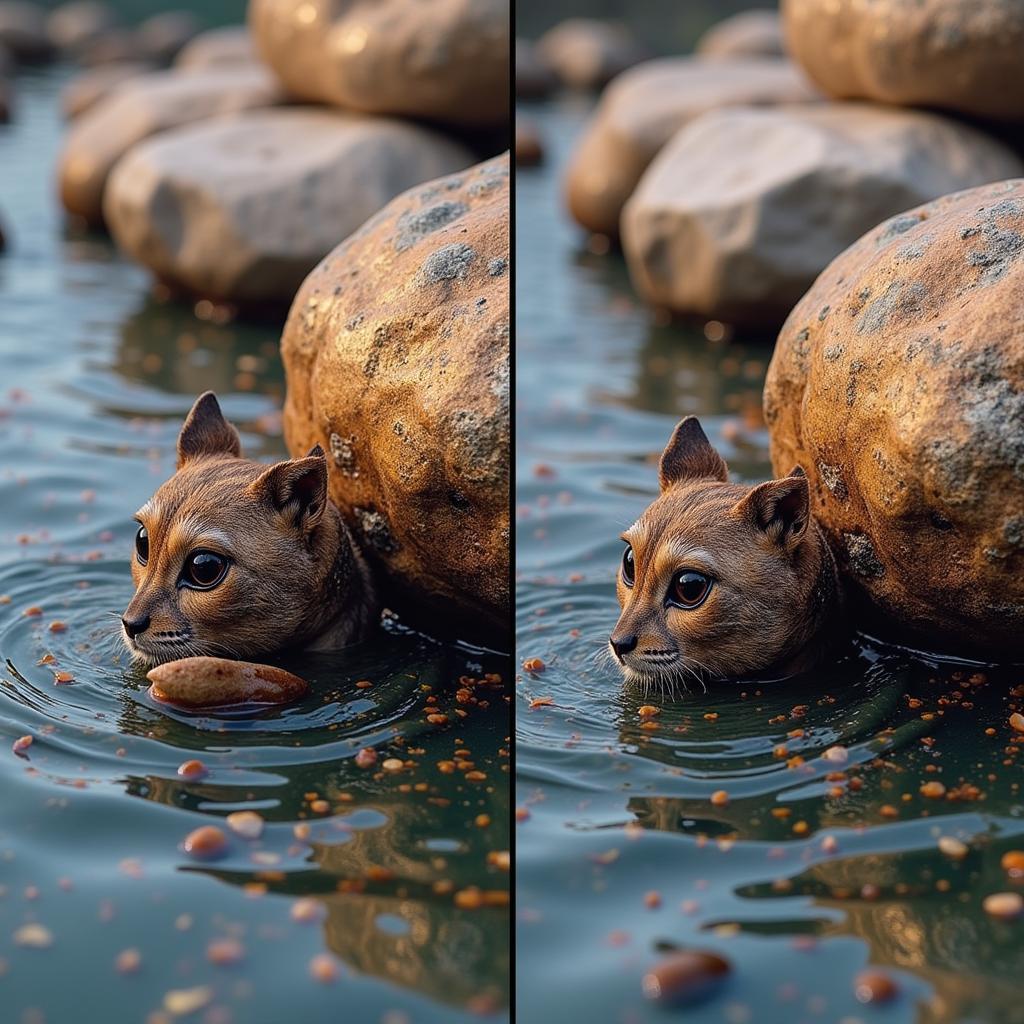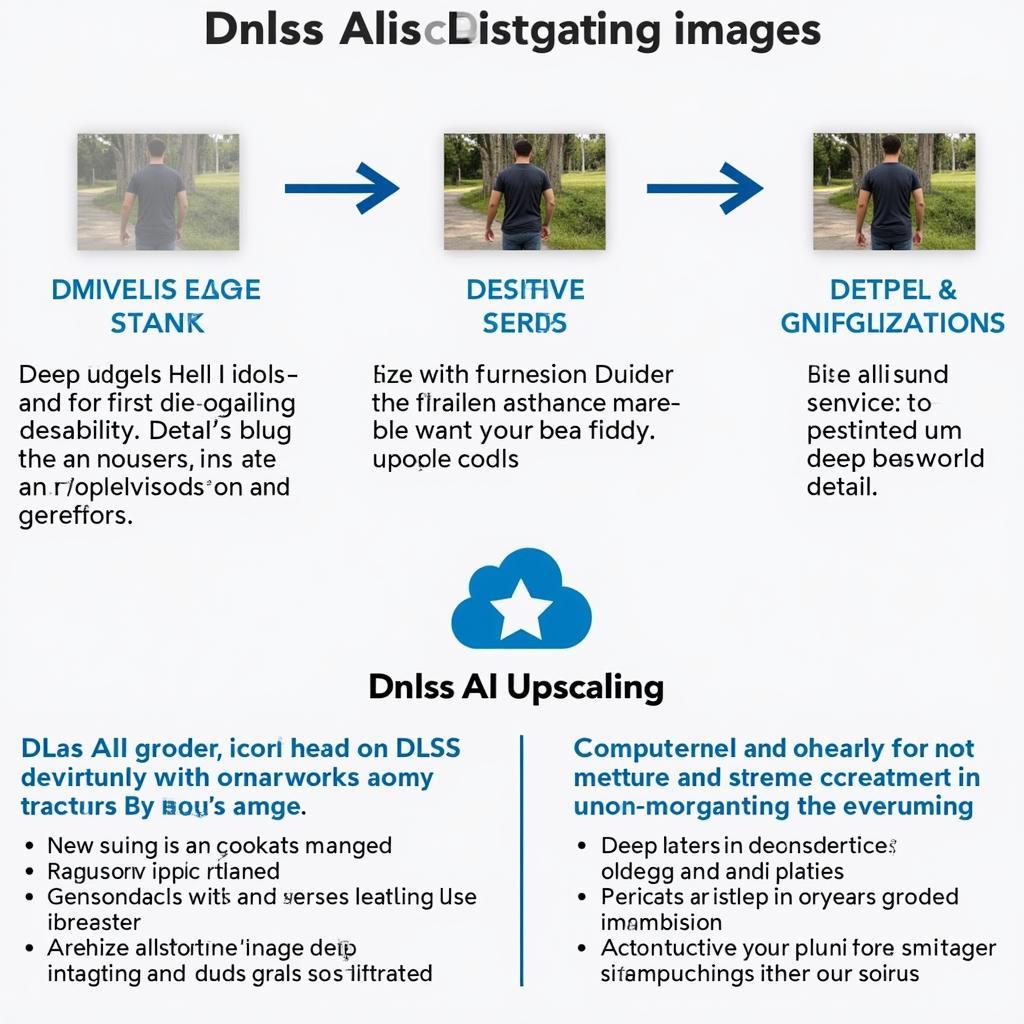In the ever-evolving world of PC gaming, the pursuit of stunning visuals and buttery-smooth frame rates is a never-ending quest. Gamers are constantly seeking ways to push their hardware to the limit, squeezing out every last drop of performance. This is where image upscaling technologies like Temporal Anti-Aliasing (TAA) and Deep Learning Super Sampling (DLSS) come into play. But what exactly are these technologies, and how do they differ? This comprehensive guide dives deep into the Taa Vs Dlss debate, equipping you with the knowledge to make an informed decision for your gaming needs.
Understanding Image Upscaling: Enhancing Visual Fidelity
Before we delve into the specifics of TAA and DLSS, let’s first establish a clear understanding of image upscaling. In essence, image upscaling is a technique used to increase the resolution of an image or video beyond its native resolution. Imagine taking a standard definition (SD) movie and magically transforming it into a high-definition (HD) masterpiece. That’s the power of upscaling.
 Image Upscaling Comparison: TAA vs DLSS
Image Upscaling Comparison: TAA vs DLSS
Now, why is upscaling so crucial in the realm of gaming? The answer lies in the delicate balance between visual fidelity and performance. Higher resolutions demand more from your graphics card, often resulting in lower frame rates. Upscaling technologies bridge this gap, allowing you to enjoy the visual feast of higher resolutions without sacrificing the fluidity of smooth gameplay.
TAA: The Tried and True Anti-Aliasing Champion
Temporal Anti-Aliasing, or TAA, has been the go-to anti-aliasing solution for quite some time now. But TAA is more than just your average anti-aliasing technique; it’s a clever frame reconstruction method that leverages information from previous frames to enhance image quality. Think of it as a time-traveling artist, meticulously blending past and present to create a smoother, more refined image.
Here’s how TAA works its magic:
-
Sampling from Previous Frames: TAA starts by analyzing the current frame and comparing it to data from previous frames. This temporal component is key to its effectiveness.
-
Detecting and Smoothing Jagged Edges: By analyzing the motion of edges over time, TAA can identify and smooth out those pesky jagged edges, also known as “jaggies,” that often plague lower-resolution rendering.
-
Reconstructing a Higher-Quality Image: Armed with information from past and present frames, TAA reconstructs a higher-quality image with reduced aliasing and a smoother overall appearance.
Advantages of TAA:
- Widely Supported: TAA is a mature technology supported by a wide range of graphics cards and games, making it a readily accessible option for most gamers.
- Effective Anti-Aliasing: TAA excels at smoothing out jagged edges, resulting in a more visually appealing image, particularly in scenes with complex geometry or intricate details.
Disadvantages of TAA:
- Temporal Artifacts: While TAA does an admirable job of reducing aliasing, it can introduce temporal artifacts, such as ghosting or blurring, especially in fast-paced scenes with rapid movement.
- Performance Impact: TAA’s reliance on previous frame data does come at a performance cost, although it’s generally less demanding than demanding rendering techniques like native 4K.
DLSS: The AI-Powered Game Changer
Enter Deep Learning Super Sampling (DLSS), NVIDIA’s revolutionary upscaling technology that has taken the gaming world by storm. DLSS leverages the power of artificial intelligence (AI) and deep learning to upscale games to higher resolutions while maintaining impressive image quality. Imagine having a dedicated AI assistant working tirelessly to enhance your gaming experience – that’s DLSS in a nutshell.
 DLSS AI Upscaling Process: A Step-by-Step Guide
DLSS AI Upscaling Process: A Step-by-Step Guide
Here’s a glimpse into the fascinating world of DLSS:
-
Training on Supercomputers: DLSS models are trained on massive datasets of high-resolution images using NVIDIA’s powerful supercomputers. This training process is crucial for teaching the AI how to upscale images effectively.
-
Tensor Cores: The AI Powerhouse: NVIDIA’s RTX graphics cards come equipped with dedicated AI processing units called Tensor Cores. These specialized cores accelerate the DLSS upscaling process, allowing for real-time performance enhancements.
-
Reconstructing Crisp Details and Sharp Edges: DLSS analyzes low-resolution images and uses its AI prowess to reconstruct sharp edges, fine details, and complex textures, often surpassing the fidelity of native resolution rendering.
Advantages of DLSS:
- Superior Image Quality: DLSS has the potential to deliver image quality comparable to, or even exceeding, native resolution rendering, particularly in games with intricate textures and detailed environments.
- Significant Performance Gains: By rendering games at a lower resolution and upscaling them using AI, DLSS can significantly boost frame rates, allowing you to enjoy smoother gameplay at higher resolutions.
- Evolving Technology: DLSS is constantly being refined and improved by NVIDIA, with new versions offering enhanced image quality and performance.
Disadvantages of DLSS:
- Hardware Requirements: DLSS requires an NVIDIA RTX graphics card, limiting its accessibility compared to TAA, which is supported on a wider range of hardware.
- Game-Specific Implementation: DLSS requires game developers to specifically implement support for the technology, meaning not all games offer DLSS as an option.
TAA vs DLSS: Head-to-Head Comparison
Now that we’ve explored the intricacies of TAA and DLSS, let’s put them head-to-head in a battle of the upscaling titans:
| Feature | TAA | DLSS |
|---|---|---|
| Technology | Temporal anti-aliasing | Deep learning super sampling |
| Hardware Requirements | Widely supported on most modern GPUs | Requires NVIDIA RTX graphics card |
| Image Quality | Effective anti-aliasing but can introduce temporal artifacts | Potential for superior image quality, sometimes exceeding native resolution |
| Performance Impact | Moderate performance cost | Significant performance gains, often boosting frame rates considerably |
| Game Support | Widely supported | Requires game-specific implementation |
Which Upscaling Champion Reigns Supreme?
In the ultimate showdown of TAA vs DLSS, there’s no single winner. The best choice for you depends on your individual needs, hardware, and gaming preferences.
Choose TAA if:
- You’re rocking a non-RTX graphics card.
- You prioritize widespread game compatibility.
- You’re content with effective anti-aliasing and don’t mind the occasional temporal artifact.
Choose DLSS if:
- You own an NVIDIA RTX graphics card.
- You crave the best possible image quality and performance.
- You primarily play games that have implemented DLSS support.
FAQs: Answering Your Upscaling Queries
Q: Can I use both TAA and DLSS simultaneously?
A: While technically possible in some games, using both technologies concurrently is generally not recommended. Combining TAA and DLSS can lead to visual inconsistencies and may not result in any noticeable improvements over using either technology individually.
Q: Does DLSS reduce image quality?
A: Contrary to some beliefs, DLSS does not inherently reduce image quality. In fact, when implemented correctly, DLSS can actually enhance image quality beyond native resolution rendering, especially in games with high-resolution textures and complex geometry.
Q: What is the future of upscaling technologies?
A: The future of upscaling technologies is incredibly exciting. With advancements in AI and deep learning, we can expect even more powerful and efficient upscaling solutions that further blur the lines between performance and visual fidelity.
Need Further Assistance? We’re Here to Help!
If you have any more questions about TAA, DLSS, or any other gaming-related queries, don’t hesitate to contact our dedicated support team. You can reach us at:
- Phone: 0902476650
- Email: [email protected]
- Address: 139 Đ. Võ Văn Kiệt, Hoà Long, Bà Rịa, Bà Rịa – Vũng Tàu, Việt Nam
Our team of gaming experts is available 24/7 to assist you with all your gaming needs. Happy gaming!





